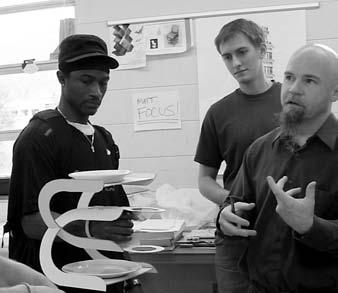
4 minute read
A Match Made in Design School
Jim Barefoot (MPD 1986) and Wendy Miller (MLAR 1986)
Wendy Miller (MLAR 1986) and Jim Barefoot (MPD 1986) met while enrolled at NC State’s College of Design. Today they are married, living in Winston-Salem with their two children, and still working in design.
Advertisement
Speaking about their successes today, they both attribute inspiration derived from Professor Joe Cox. While in school, Miller was a teaching assistant for Cox’s Color & Light class while Barefoot was enrolled in the class.
The two fondly remember Cox’s nighttime community art class critiques as a major bonding force. In fact, the pair attended Cox’s watercolor workshop in Oriental, N.C., for their honeymoon trip.

Miller’s Work Combines Design and Science
An English major with pre-med sciences under her belt, Wendy Miller decided to continue her studies after working for a landscape architect in the University of Virginia (UVA) campus planning department. “It opened up a whole new world to me,” says Miller.
After UVA, Miller moved to Chapel Hill. While there, she enrolled in a planning course that led her to NC State’s design school. She met Barefoot during her second year.
Today, Miller is using her talents and interests in the Transportation Planning Department for the City of Winston-Salem. As Principal Planner, she works with the Winston-Salem Metropolitan Planning Organization (MPO), and she is involved with the overall system planning including bike paths, pedestrians, and long-range planning. A new project for Miller is participating in developing an Aesthetics Manual for the N.C. Department of Transportation (NCDOT). The federal government is pushing comprehensive, multimodal transportation planning, which includes all modes of transportation from trains to passenger cars to buses and airplanes. NCDOT is trying to revamp how it plans for aesthetics in roadway design.
Context sensitive design, the newest government buzz words in roadway planning, serves to build the road in the landscape context. When speaking of this, Miller shares that “landscape architects were the first to design scenic parkways that used the land to shape the road without destroying the landscape.”
Her first affiliation is with the American Society of Landscape Architects (ASLA) and she served as president of the North Carolina Chapter in 1996. She participates in the Transportation Research Board as a member of the Landscape and Environmental Design Committee.
Miller was a charter member of the alumni advisory board for the Landscape Architecture Department at NC State. When she was asked to serve, Miller confides she reviewed her projects from design school to get reacquainted with the work. “Half of my projects were road-related. It was stunning to realize I had done that,” she says. “One of my projects was working on sign ordinances and visual aesthetics in the public realm. Roads are a big part of that.”
Keeping in touch with the people from school is important to Miller. She says her landscape architecture training brings a different way of looking at the problems she runs into as a transportation planner. “It’s a comprehensive view,” she explains. Professor’s Question Leads to a Career
While majoring in Wood Science and Technology at NC State, Barefoot had designed a table. On the advice of his father, who as a faculty member in Forestry had served on committees with Vince Foote, Barefoot showed it to Foote for input.
Barefoot says he will never forget Foote’s response, “Where’s the chair?” Inspired by Foote’s challenge to build a chair, Barefoot transferred from the master’s program in Wood Science into the Industrial Design master’s program. He was in and out of the program because he worked, but continued work on his master’s part-time.
When he and Miller relocated to Winston-Salem, Barefoot began working with Hy Zelkowitz at Stendig doing product development of lounge chairs. They would take the sketches from the Vignellis or SOM and convert them into something that could be manufactured. Barefoot also made the prototypes for showroom samples, which was a crash course in upholstery. Unfortunately, Stendig went out of business.
Barefoot then worked at Brayton International in product development. He served as an in-house designer. While there, several of his chair designs were produced.
After that experience, he set up as an independent designer and has “a 12-foot commute across his deck.” Barefoot either responds to design briefs from clients or speculates by creating chair designs that he thinks companies might need. He creates computer renderings for presentations and often builds prototypes. His clients then license the designs and pay him on a royalty basis. His clients include Brayton, HBF, Paoli, AGI, and Patrician.
His success is linked to maintaining long relationships with clients. That generates more than enough work to keep him going part time. Barefoot says his design business is just one of his jobs. “I’m a stay-at-home dad for our 14- and 11-year olds, I renovate the house, and I have my design business.”
As for the first chair Barefoot designed at the request of Foote to match his table….it is still in their home. Barefoot’s chair Alana, produced by Patrician.











